Influence of the Matrix Material and Tribological Contact Type on the Antifriction Properties of Hybrid Reinforced Polyimide-Based Nano- and Microcomposites
Abstract
:1. Introduction
2. Materials and Methods
2.1. Materials
2.2. Fabrication of the Composites
3. Results
3.1. Mechanical Properties
- The elastic modulus values of the PEI-based composites were higher by 0.3–0.6 GPa than those of the PI-based analogs;
- For the PEI-based composites, the Shore D hardness levels were greater by 4–5 units than those for the PI-based analogs;
- The ultimate tensile strengths of the PI-based composites loaded with µPTFE were higher by 26 and 42 MPa than those for the PEI-based samples.
3.2. The Point Tribological Contact
3.3. Linear Tribological Contact
4. Discussion
5. Conclusions
Supplementary Materials
Author Contributions
Funding
Institutional Review Board Statement
Data Availability Statement
Acknowledgments
Conflicts of Interest
References
- Farfan-Cabrera, L.I.; Tapia-Gaspar, M.; Pérez-González, J. Tribology of Polymer Matrix Composites within the Automotive Industry. Encycl. Mater. Compos. 2021, 1, 970–982. [Google Scholar] [CrossRef]
- Friedrich, K. Polymer Composites for Tribological Applications. Adv. Ind. Eng. Polym. Res. 2018, 1, 3–39. [Google Scholar] [CrossRef]
- Constantin, C.P.; Aflori, M.; Damian, R.F.; Rusu, R.D. Biocompatibility of Polyimides: A Mini-Review. Materials 2019, 12, 3166. [Google Scholar] [CrossRef] [PubMed] [Green Version]
- Gheisari, R.; Polycarpou, A.A. Tribological Performance of Graphite-Filled Polyimide and PTFE Composites in Oil-Lubricated Three-Body Abrasive Conditions. Wear 2019, 436–437, 203044. [Google Scholar] [CrossRef]
- Mu, L.; Zhu, J.; Fan, J.; Zhou, Z.; Shi, Y.; Feng, X.; Wang, H.; Lu, X. Self-Lubricating Polytetrafluoroethylene/Polyimide Blends Reinforced with Zinc Oxide Nanoparticles. J. Nanomater. 2015, 2015, 545307. [Google Scholar] [CrossRef] [Green Version]
- Kumar, R.; Malaval, B.; Antonov, M.; Zhao, G. Performance of Polyimide and PTFE Based Composites under Sliding, Erosive and High Stress Abrasive Conditions. Tribol. Int. 2020, 147, 106282. [Google Scholar] [CrossRef]
- Ogbonna, V.E.; Popoola, P.I.; Popoola, O.M.; Adeosun, S.O. A Review on Recent Advances on Improving Polyimide Matrix Nanocomposites for Mechanical, Thermal, and Tribological Applications: Challenges and Recommendations for Future Improvement. J. Thermoplast. Compos. Mater. 2023, 36, 836–865. [Google Scholar] [CrossRef]
- Marathe, U.N.; Bijwe, J. High Performance Polymer Composites—Influence of Processing Technique on the Fiber Length and Performance Properties. Wear 2020, 446–447, 203189. [Google Scholar] [CrossRef]
- Aleksandrova, D.; Komarova, M.; Egorov, A. Topology and Structure Analysis of Carbon Fiber-Reinforced Polyimide Composites. E3S Web Conf. 2023, 376, 01023. [Google Scholar] [CrossRef]
- Hu, J.; Wei, H.; Wu, Q.; Zhao, X.; Chen, K.; Sun, J.; Cui, Z.; Wang, C. Preparation and Characterization of Luminescent Polyimide/Glass Composite Fiber. J. Mater. Res. Technol. 2022, 18, 4329–4339. [Google Scholar] [CrossRef]
- Panin, S.V.; Luo, J.; Buslovich, D.G.; Alexenko, V.O.; Kornienko, L.A.; Bochkareva, S.A.; Byakov, A.V. Experimental—FEM Study on Effect of Tribological Load Conditions on Wear Resistance of Three-component High-strength Solid-lubricant PI-based Composites. Polymers 2021, 13, 2837. [Google Scholar] [CrossRef] [PubMed]
- Chen, B.; Li, X.; Jia, Y.; Li, X.; Yang, J.; Yan, F.; Li, C. MoS2 Nanosheets-Decorated Carbon Fiber Hybrid for Improving the Friction and Wear Properties of Polyimide Composite. Compos. Part A Appl. Sci. Manuf. 2018, 109, 232–238. [Google Scholar] [CrossRef]
- Friedrich, K.; Schlarb, A. (Eds.) Tribology of Polymeric Nanocomposites. In Friction and Wear of Bulk Materials and Coatings, 2nd ed.; Butterworth-Heinemann: Oxford, UK, 2013. [Google Scholar]
- Panin, S.V.; Alexenko, V.O.; Buslovich, D.G. High Performance Polymer Composites: A Role of Transfer Films in Ensuring Tribological Properties—A Review†. Polymers 2022, 14, 975. [Google Scholar] [CrossRef]
- Friedrich, K.; Flöck, J.; Váradi, K.; Néder, Z. Experimental and Numerical Evaluation of the Mechanical Properties of Compacted Wear Debris Layers Formed between Composite and Steel Surfaces in Sliding Contact. Wear 2001, 251, 1202–1212. [Google Scholar] [CrossRef]
- Dong, F.; Hou, G.; Cao, F.; Yan, F.; Liu, L.; Wang, J. The Lubricity and Reinforcement of Carbon Fibers in Polyimide at High Temperatures. Tribol. Int. 2016, 101, 291–300. [Google Scholar] [CrossRef]
- Hutchings, I.; Shipway, P. Friction. In Tribology; Butterworth Heinemann: Oxford, UK, 2017; pp. 37–77. [Google Scholar] [CrossRef]
- Zhu, T.; Qian, C.; Zheng, W.; Bei, R.; Liu, S.; Chi, Z.; Chen, X.; Zhang, Y.; Xu, J. Modified Halloysite Nanotube Filled Polyimide Composites for Film Capacitors: High Dielectric Constant, Low Dielectric Loss and Excellent Heat Resistance. RSC Adv. 2018, 8, 10522–10531. [Google Scholar] [CrossRef]
- Akar, A.O.; Yildiz, U.H.; Tirkes, S.; Tayfun, U.; Hacivelioglu, F. Influence of Carbon Nanotube Inclusions to Electrical, Thermal, Physical and Mechanical Behaviors of Carbon-Fiber-Reinforced ABS Composites. Carbon Lett. 2022, 32, 987–998. [Google Scholar] [CrossRef]
- Sivanand, R.; Gajendiran, V.; Alshamsi, H.A.; Raffik, R.; Sharma, A.; Pant, K. Carbon Based Nanomaterials Technology for Tribology Applications—A Review. In Recent Advancements in Biomedical Engineering; Trans Tech Publications Ltd.: STAFA-Zurich, Switzerland, 2022; Volume 117, pp. 9–16. [Google Scholar]
- Alam, K.I.; Bragaw, P.; Burris, D.L. Isolating the Tribochemical and Mechanical Effects of Nanofillers on PTFE Wear. Wear 2022, 494–495, 204256. [Google Scholar] [CrossRef]
- Fu, Y.F.; Li, J.; Zhang, F.Q.; Xu, K. The Preparation and the Friction and Wear Behaviours of TiO2/CNT/PI Composite Film. J. Exp. Nanosci. 2016, 11, 459–469. [Google Scholar] [CrossRef] [Green Version]
- Zhao, Y.; Qi, X.; Dong, Y.; Ma, J.; Zhang, Q.; Song, L.; Yang, Y.; Yang, Q. Mechanical, Thermal and Tribological Properties of Polyimide/Nano-SiO2 Composites Synthesized Using an In-Situ Polymerization. Tribol. Int. 2016, 103, 599–608. [Google Scholar] [CrossRef] [Green Version]
- Yuan, H.; Yang, S.; Liu, X.; Wang, Z.; Ma, L.; Hou, K.; Yang, Z.; Wang, J. Polyimide-Based Lubricating Coatings Synergistically Enhanced by MoS2@HCNF Hybrid. Compos. Part A Appl. Sci. Manuf. 2017, 102, 9–17. [Google Scholar] [CrossRef]
- Zhou, S.; Li, W.; Zhao, W.; Li, Q.; Liu, C.; Fang, Z.; Gao, X. Tribological Behaviors of Polyimide Composite Coatings Containing Carbon Nanotubes and Fluorinated Graphene with Hybrid Phase or Blend Phase. Prog. Org. Coatings 2020, 147, 105800. [Google Scholar] [CrossRef]
- Wang, Q.; Zhang, X.; Pei, X. A Synergistic Effect of Graphite and Nano-CuO on the Tribological Behavior of Polyimide Composites. J. Macromol. Sci. Part B Phys. 2011, 50, 213–224. [Google Scholar] [CrossRef]
- Milosevic, M.; Valášek, P.; Ruggiero, A. Tribology of Natural Fibers Composite Materials: An Overview. Lubricants 2020, 8, 42. [Google Scholar] [CrossRef] [Green Version]
- Panin, S.V.; Luo, J.; Buslovich, D.G.; Alexenko, V.O.; Kornienko, L.A.; Byakov, A.V.; Shugurov, A.R.; Panin, K.S.; Berto, F. Effect of Tribological Layer Formation on Wear Resistance of PI- and PEI-Based Nanocomposites in Point and Line Contacts. Appl. Sci. 2023, 13, 3848. [Google Scholar] [CrossRef]
- Guo, L.; Zhang, G.; Wang, D.; Zhao, F.; Wang, T.; Wang, Q. Significance of Combined Functional Nanoparticles for Enhancing Tribological Performance of PEEK Reinforced with Carbon Fibers. Compos. Part A Appl. Sci. Manuf. 2017, 102, 400–413. [Google Scholar] [CrossRef]
- Molazemhosseini, A.; Tourani, H.; Khavandi, A.; Eftekhari Yekta, B. Tribological Performance of PEEK Based Hybrid Composites Reinforced with Short Carbon Fibers and Nano-Silica. Wear 2013, 303, 397–404. [Google Scholar] [CrossRef]
- Rodriguez, V.; Sukumaran, J.; Schlarb, A.K.; De Baets, P. Influence of Solid Lubricants on Tribological Properties of Polyetheretherketone (PEEK). Tribol. Int. 2016, 103, 45–57. [Google Scholar] [CrossRef]
- Panin, S.V.; Luo, J.; Buslovich, D.G.; Alexenko, V.O.; Kornienko, L.A.; Byakov, A.V.; Paimushin, V.N.; Shugurov, A.R. Role of Testing Conditions in Formation of Tribological Layers at Line Contacts of Antifriction CF-Reinforced PI- and PEI-Based Composites†. Molecules 2022, 27, 6376. [Google Scholar] [CrossRef]
- Pretsch, E.; Bühlmann, P.; Badertscher, M. Structure Determination of Organic Compounds: Tables of Spectral Data; Springer: Berlin/Heidelberg, Germany, 2009; ISBN 9783540938095. [Google Scholar]
- Ashby, M.F. Materials Selection in Mechanical Design; Elsevier: Burlington, NY, USA, 2011; ISBN 9780080952239. [Google Scholar]
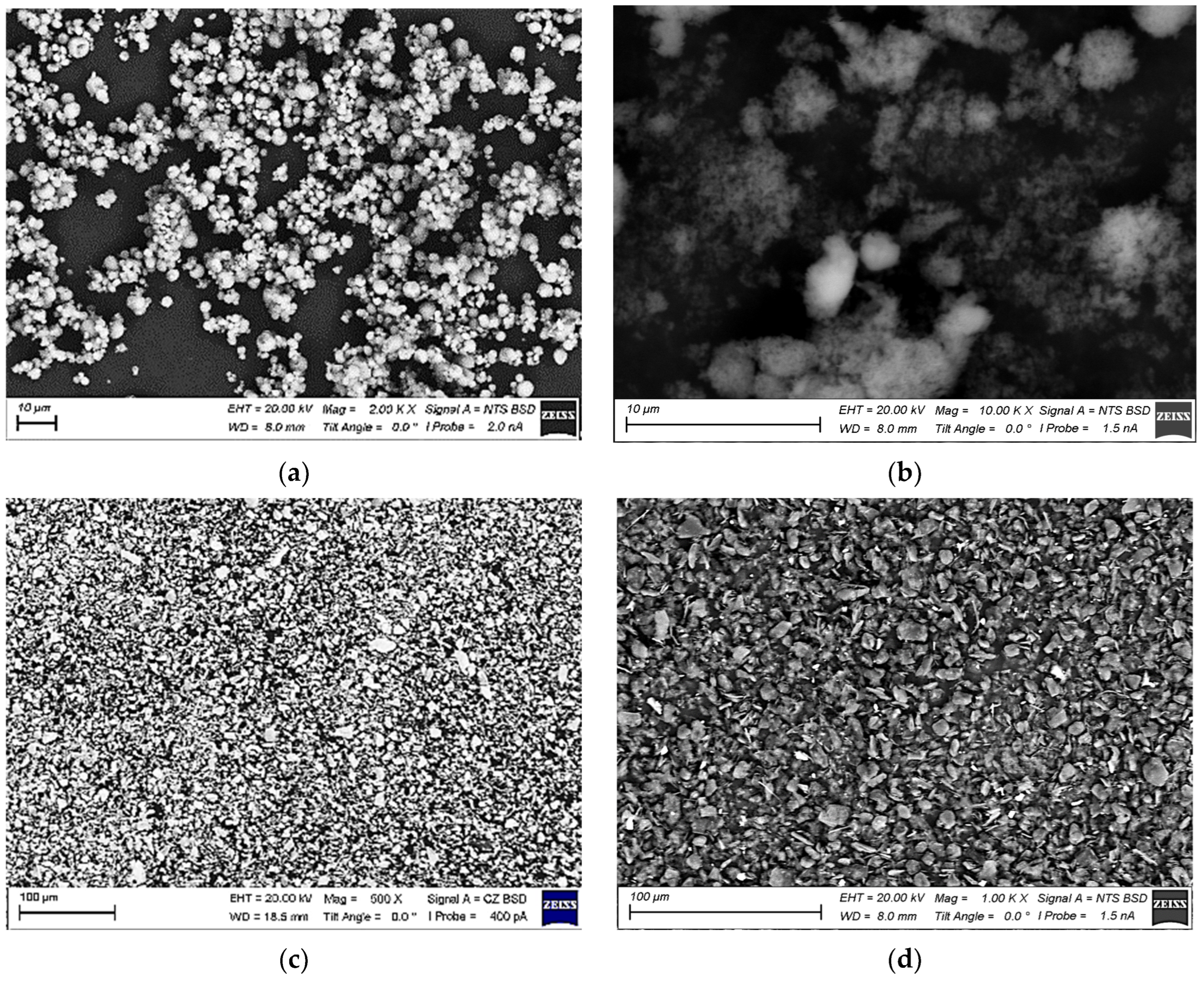
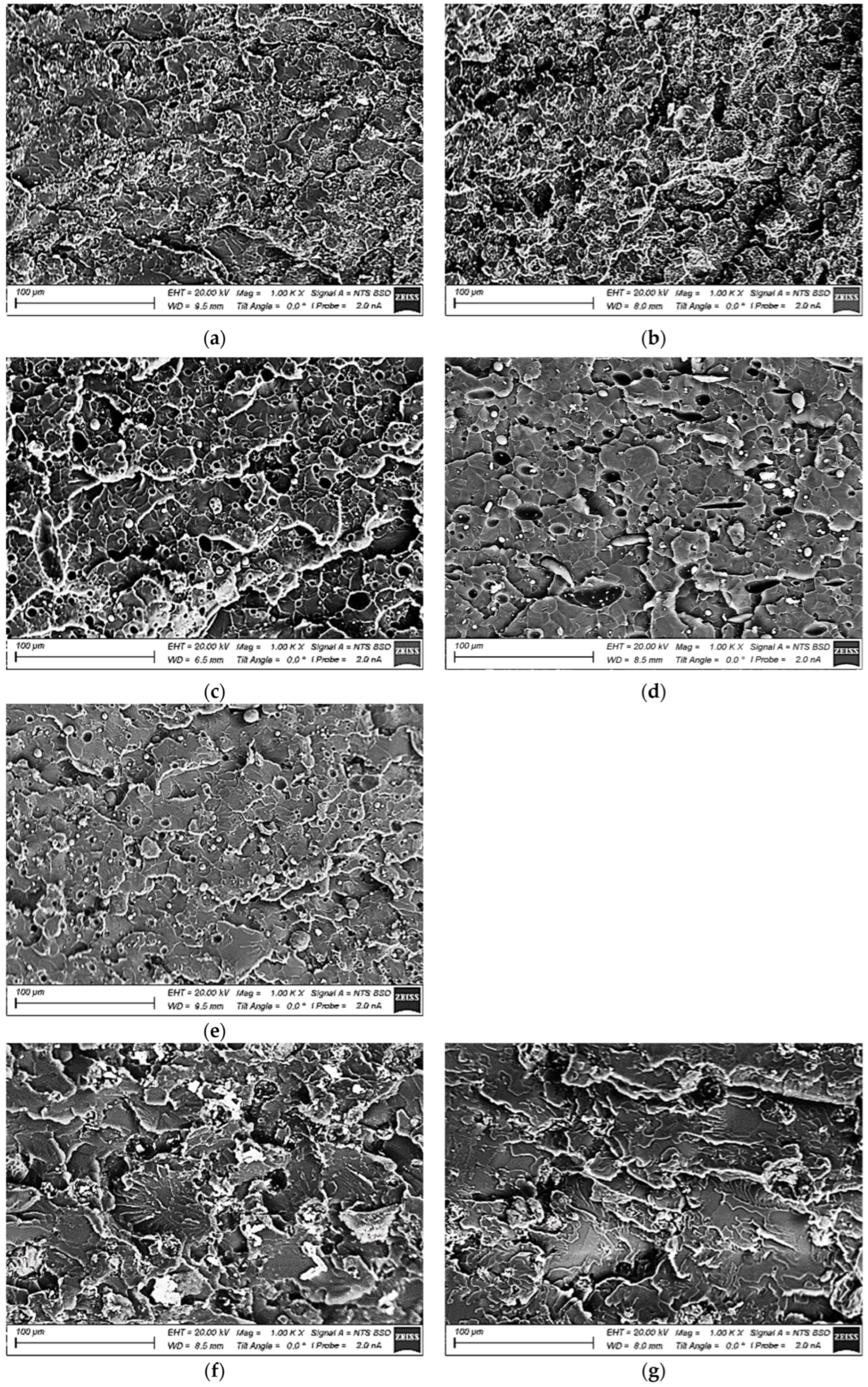
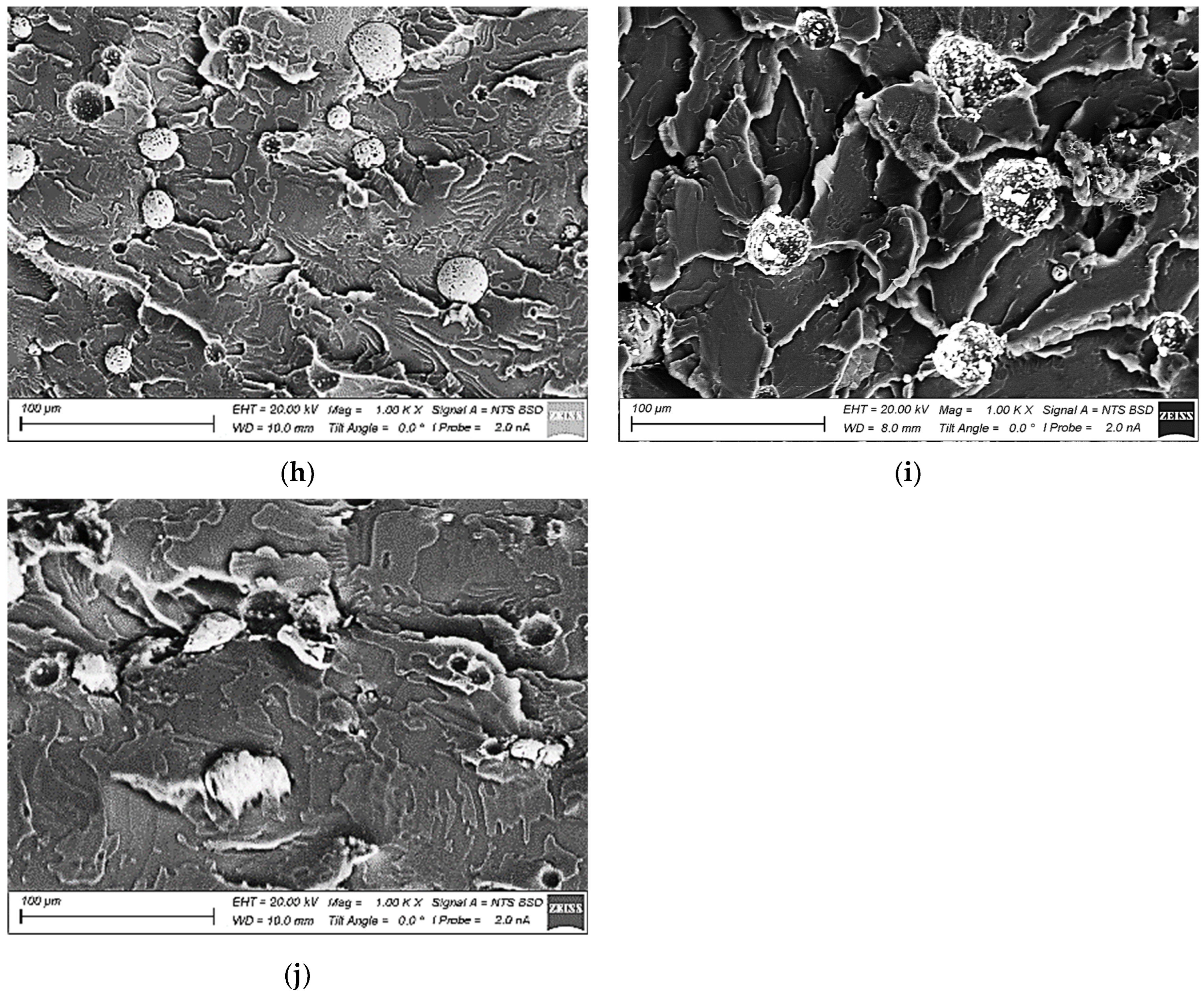
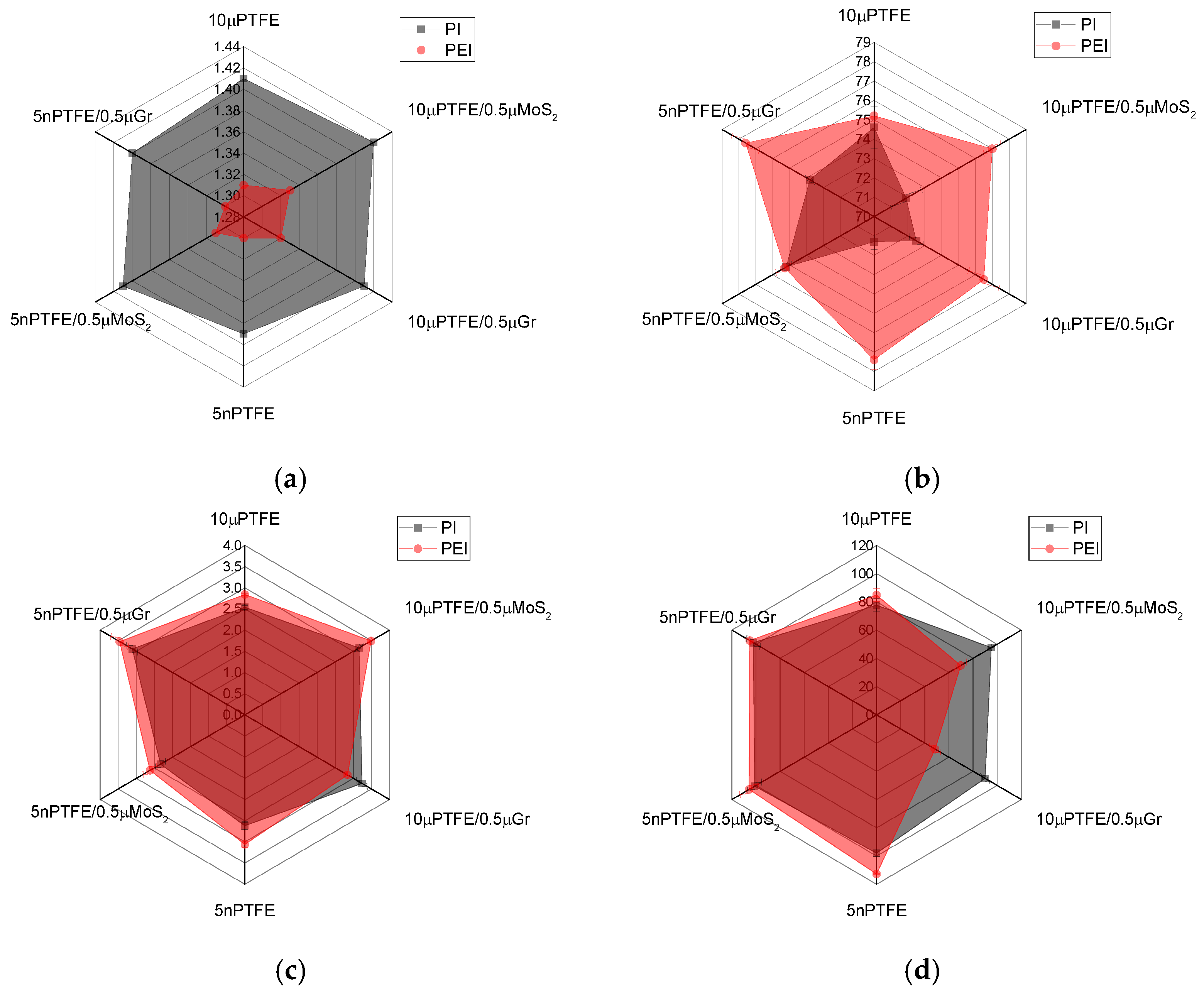
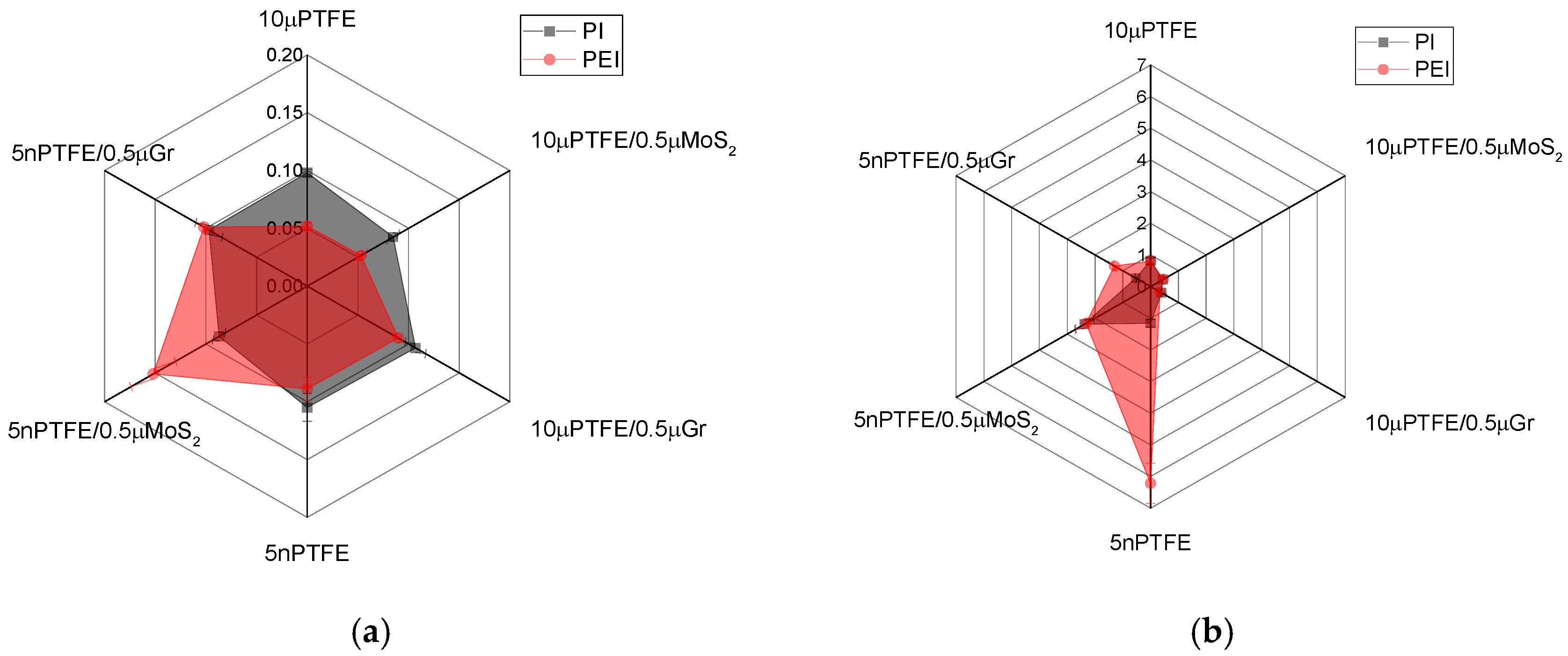





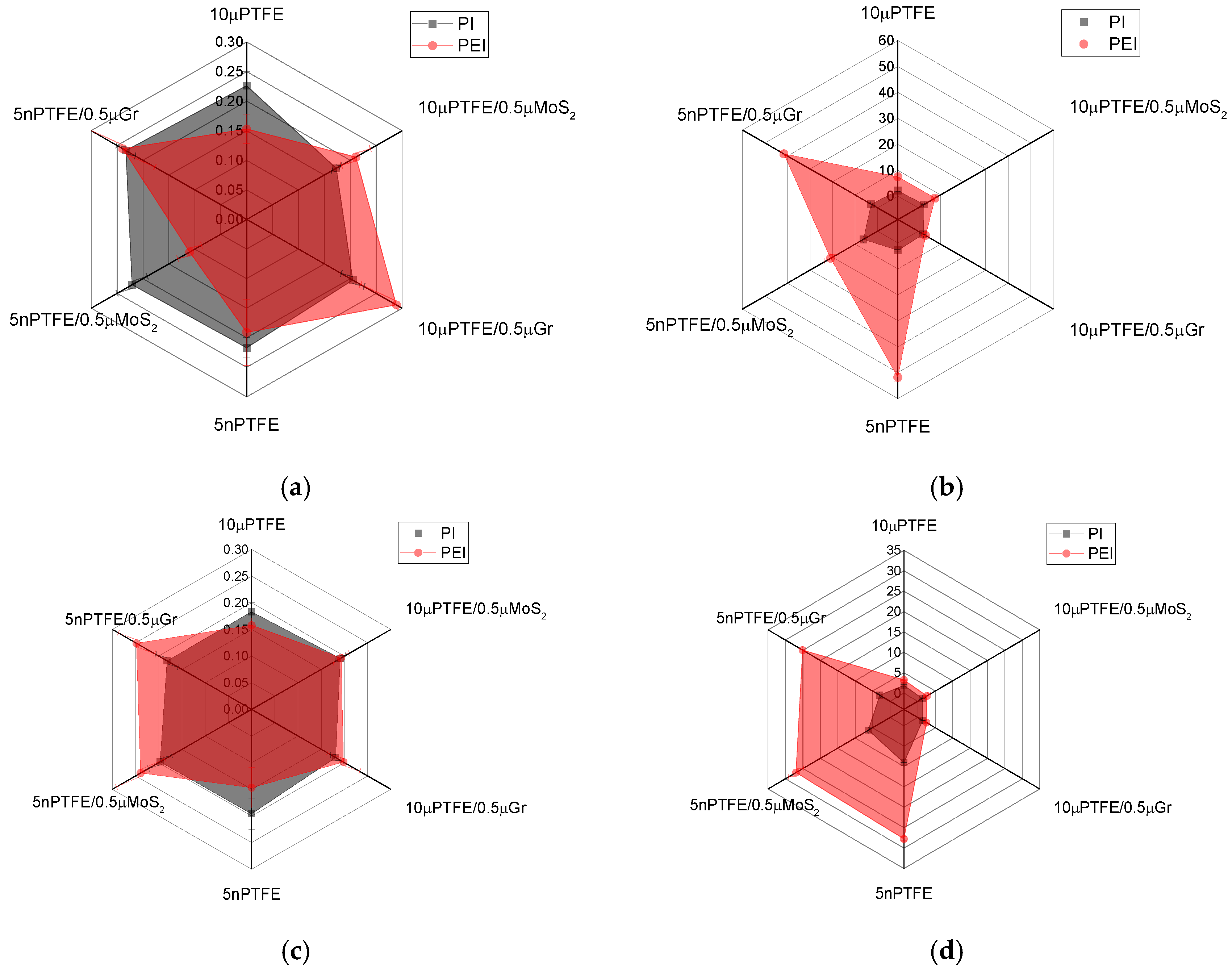
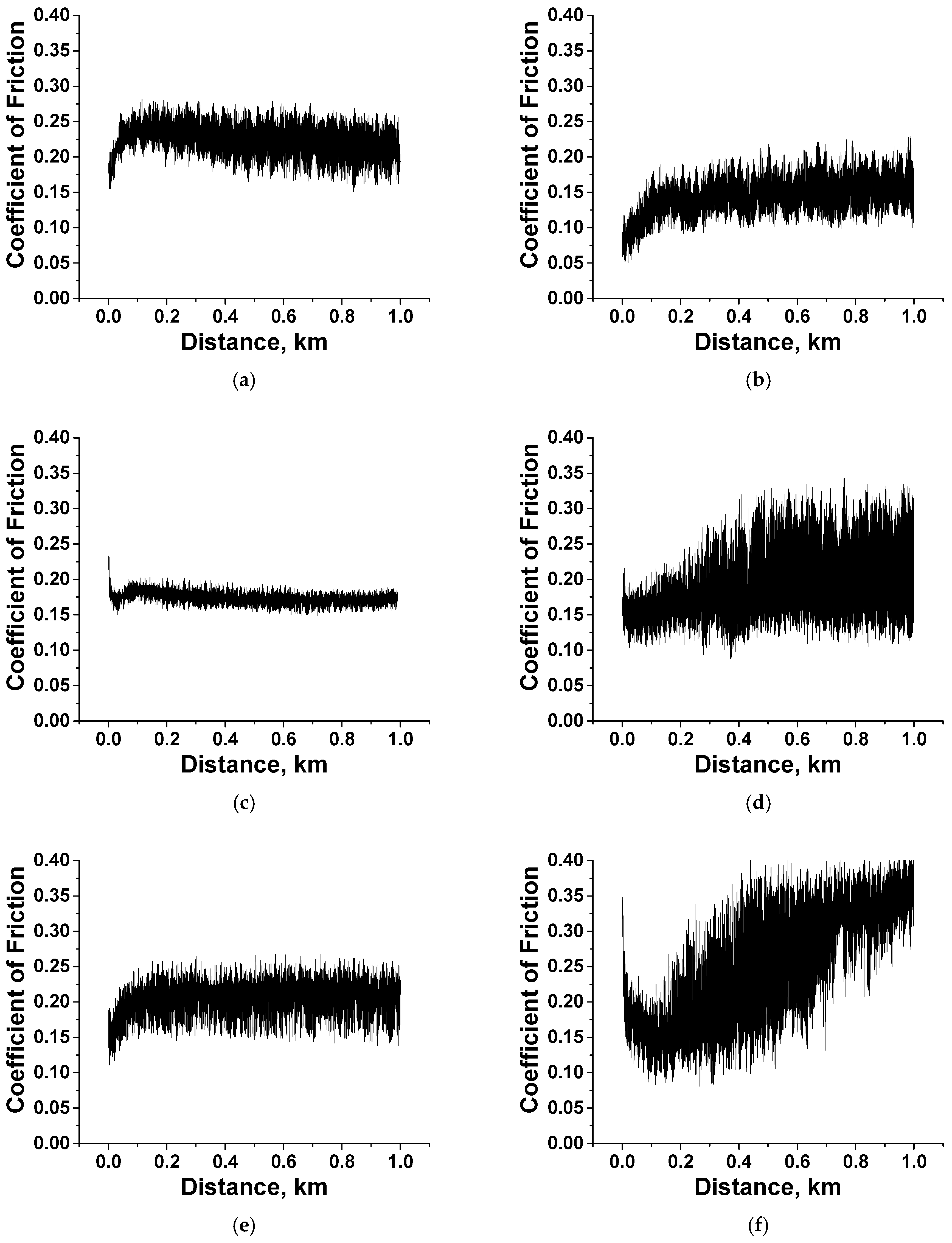

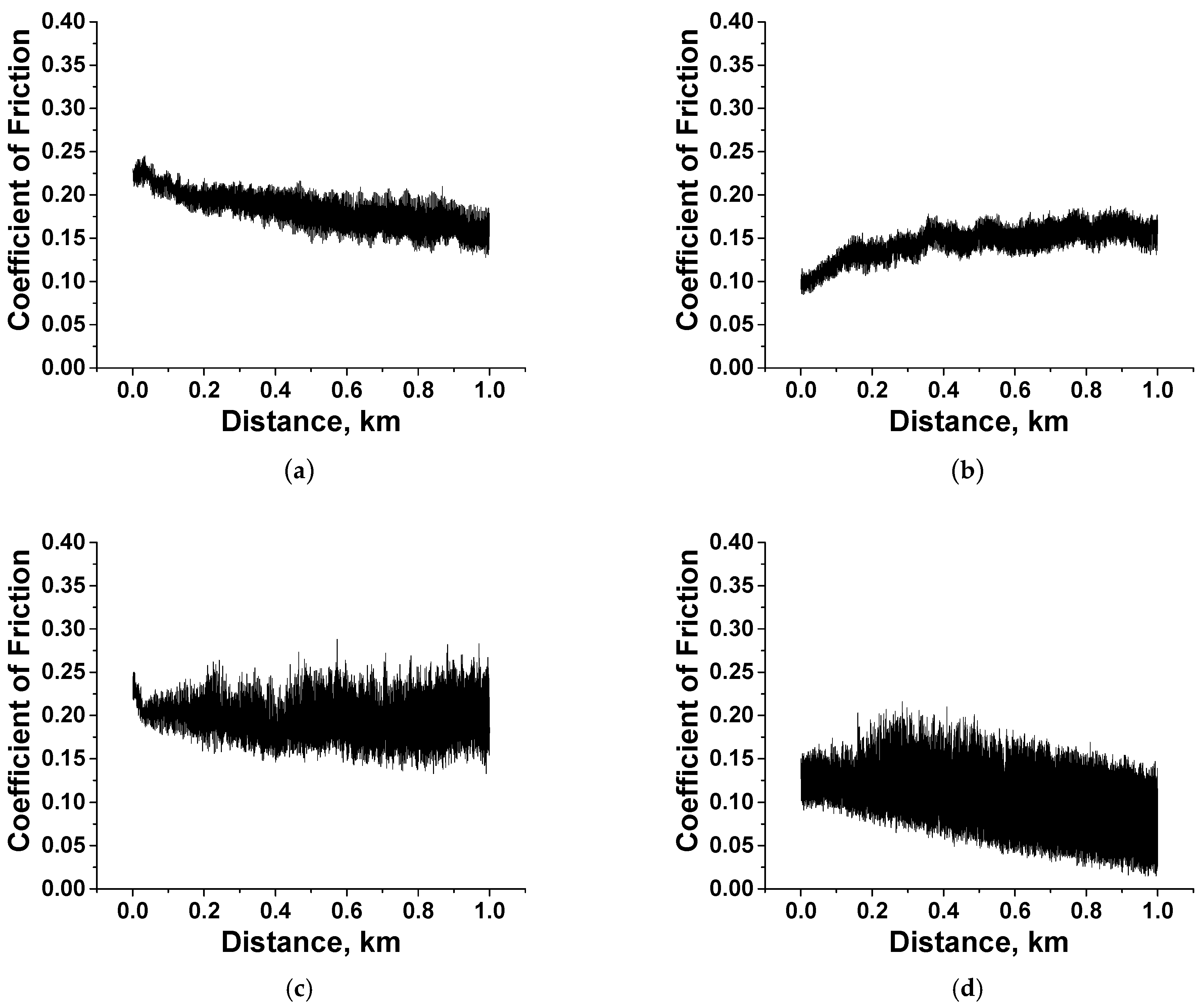
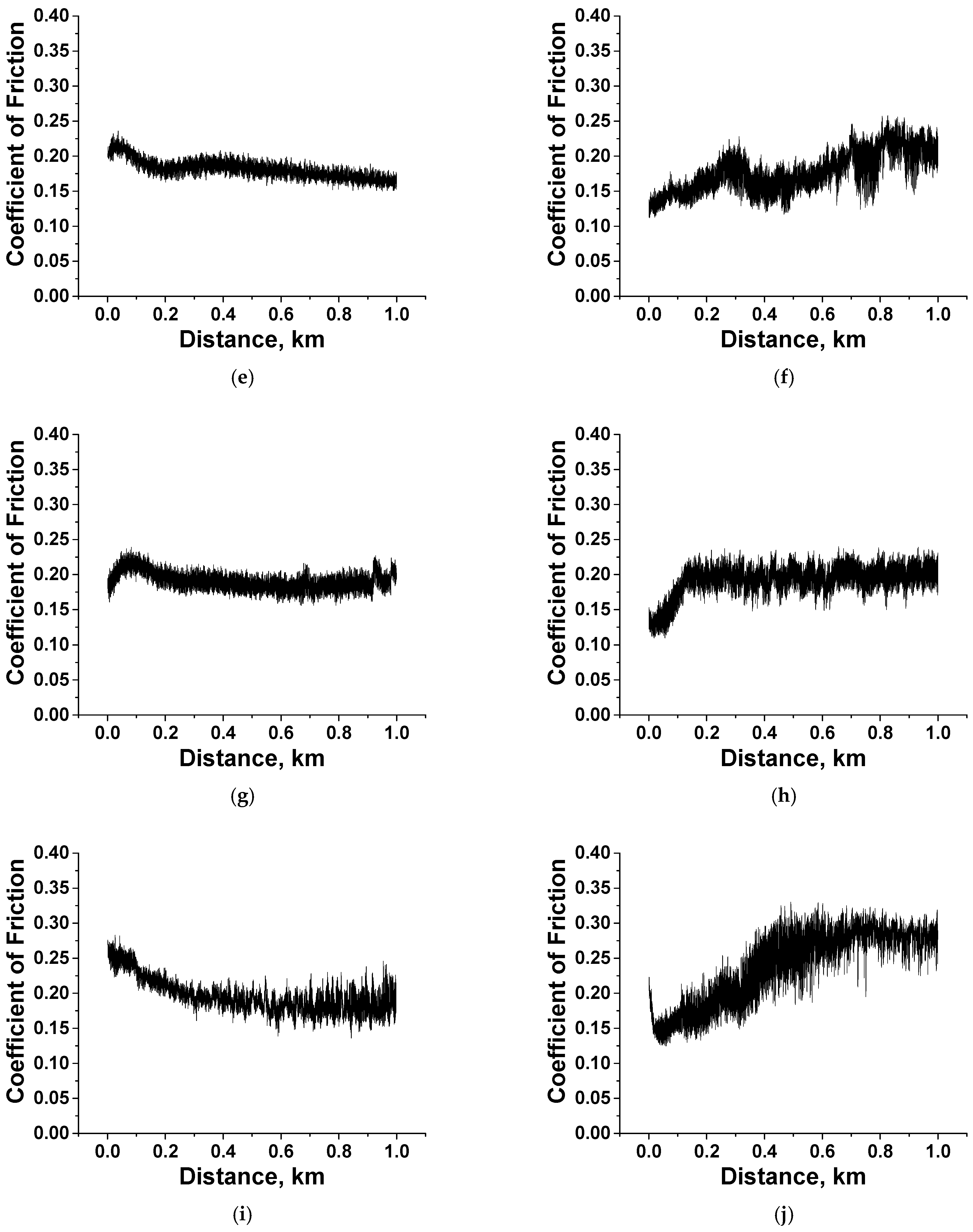




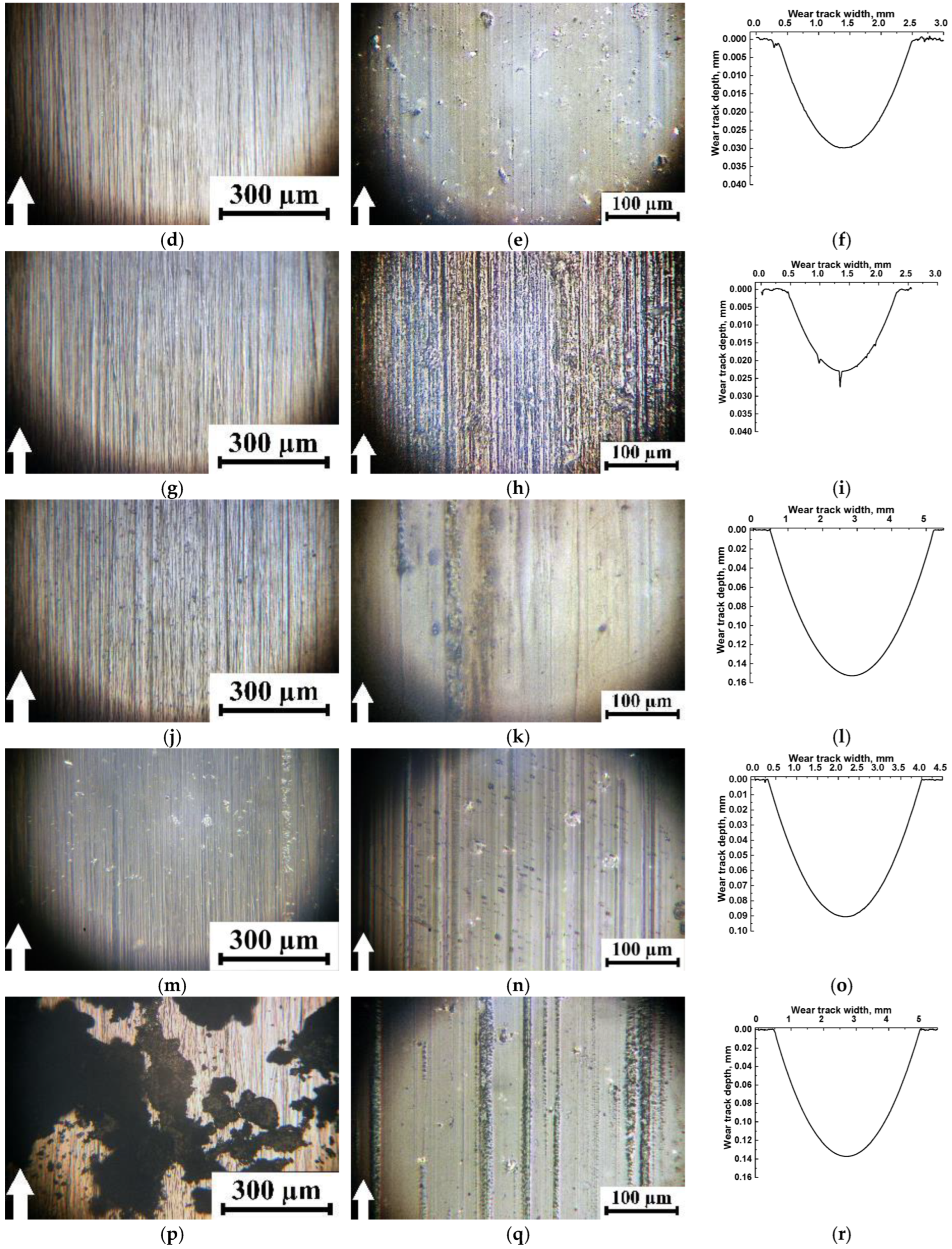
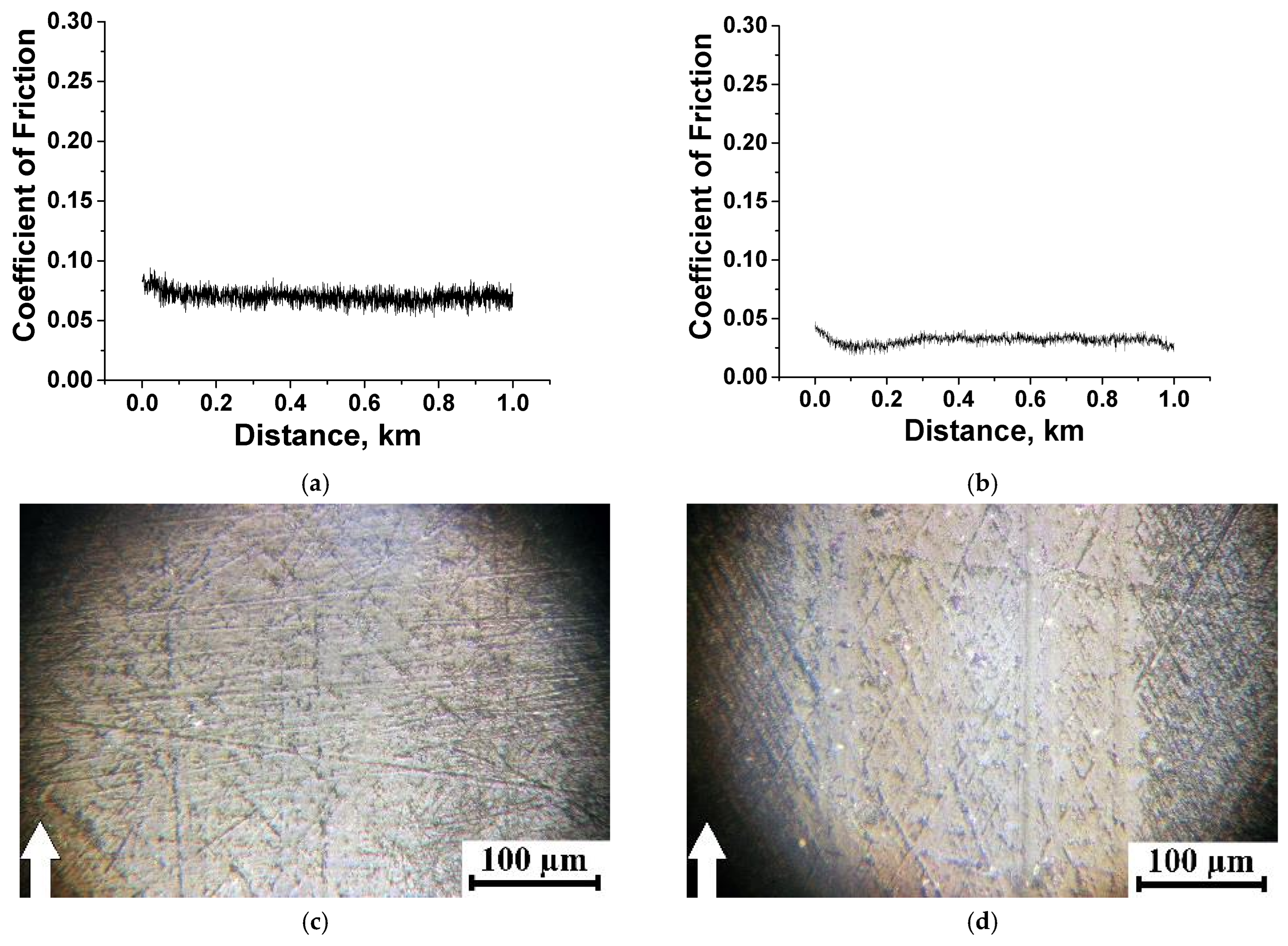

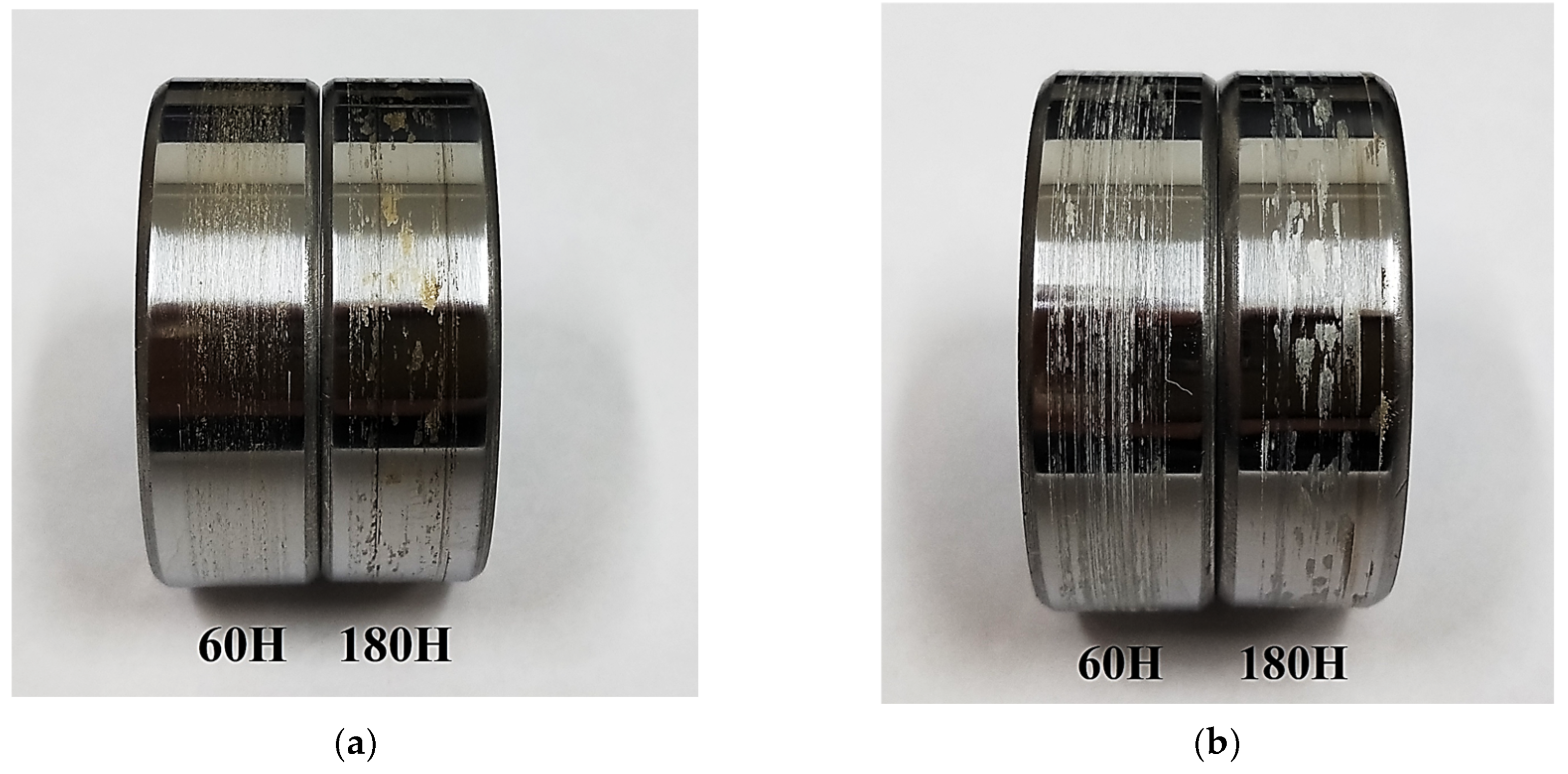

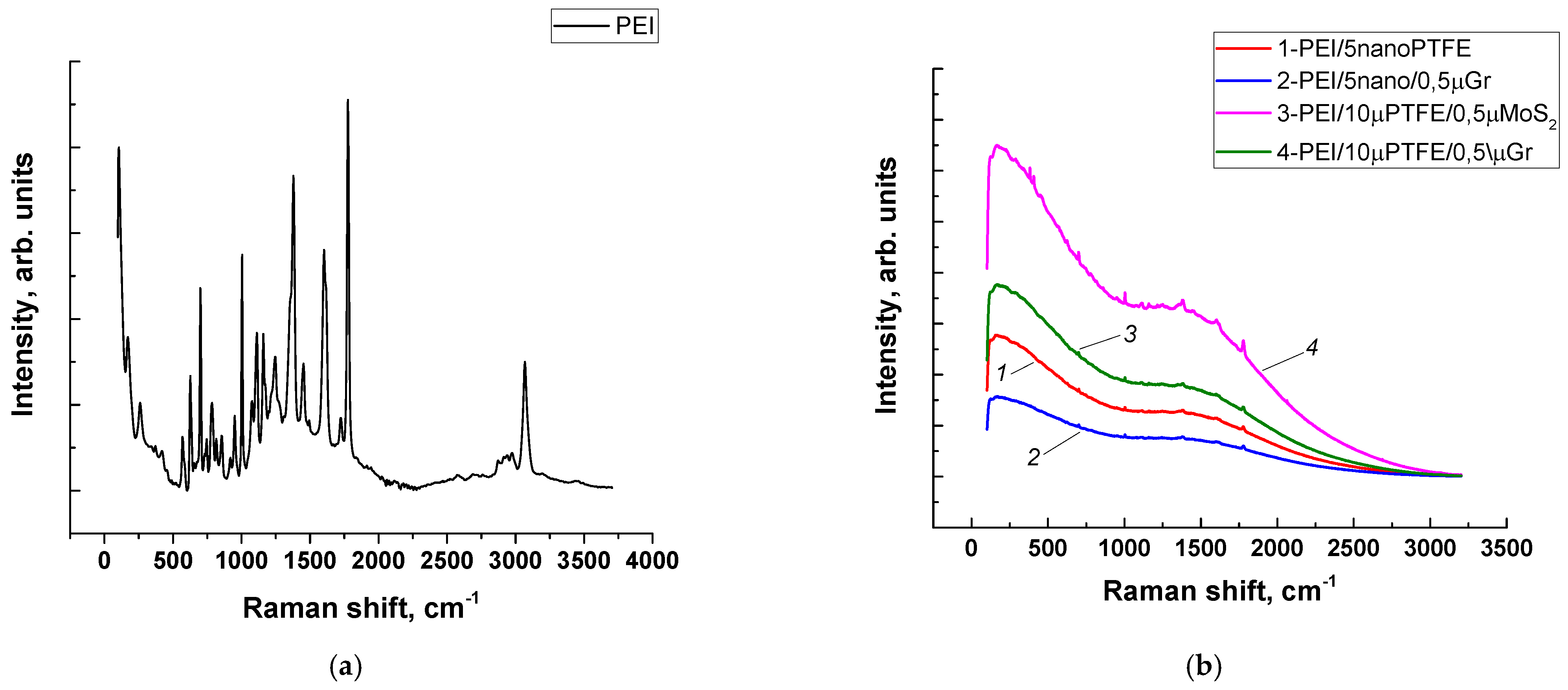

| Powders | Dimension | Manufacturer |
|---|---|---|
| Matrix | ||
| PI powder | average particle size of 16 µm | PI-1600, Solver, Jiande, China |
| PEI powder | average particle size of 20 µm | PEI ROOH, Jiande, China |
| Solid lubricants | ||
| The “Fluralit” fine PTFE powder | average particle size of <3 µm | “Fluralit synthesis” LLC, Moscow, Russia |
| Molybdenum disulfide | average particle size of 1–7 µm | Climax Molybdenum, Phoenix, AZ, USA |
| PTFE nanoparticles | average particle size of 100 nm | Daikin, Osaka, Japan |
| Graphite particles | average particle size of 10 µm | Kegong Metallurgical Materials Co., Ltd., Xingtai, China |
| Composition, wt.% | Designation |
|---|---|
| PI + 10%PTFE (micro) | PI/10µPTFE |
| PI + 10% PTFE (micro) + 0.5% MoS2 (micro) | PI/10µPTFE/0.5µMoS2 |
| PI + 10% PTFE (micro) + 0.5% Graphite (micro) | PI/10µPTFE/0.5µGr |
| PI + 5%PTFE (nano) | PI/5nanoNPTFE |
| PI + 5%PTFE (nano) + 0.5% MoS2 (micro) | PI/5nanoPTFE/0.5µMoS2 |
| PI + 5%PTFE (nano) + 0.5% Graphite (micro) | PI/5nanoPTFE/0.5µGr |
| PEI + 10%PTFE (micro) | PEI/10µPTFE |
| PEI + 10% PTFE (micro) + 0.5% MoS2 (micro) | PEI/10µPTFE/0.5µMoS2 |
| PEI + 10% PTFE (micro) + 0.5% Graphite (micro) | PEI/10µPTFE/0.5µGr |
| PEI + 5%PTFE (nano) | PEI/5nanoNPTFE |
| PEI + 5%PTFE (nano) + 0.5% MoS2 (micro) | PEI/5nanoPTFE/0.5µMoS2 |
| PEI + 5%PTFE (nano) + 0.5% Graphite (micro) | PEI/5nanoPTFE/0.5µGr |
| No. | Composite | CoF | WR, mm3/N·m, 10−6 |
|---|---|---|---|
| 1 | PI/10µPTFE/0.5µMoS2/ PEI/10µPTFE/0.5µMoS2 | 0.069 ± 0.002/0.067 ± 0.006 | 0.54 ± 0.06/0.22 ± 0.02 |
| 2 | PI/10µPTFE/0.5µGr/ PEI/10µPTFE/0.5µGr | 0.069 ± 0.001/0.075 ± 0.004 | 0.31 ± 0.03/0.20 ± 0.02 |
| 3 | PI/5nanoPTFE/0.5µMoS2/ PEI/5nanoPTFE/0.5µMoS2 | 0.129 ± 0.017/0.137 ± 0.029 | 1.72 ± 0.16/1.78 ± 0.23 |
| 4 | PI/5nanoPTFE/0.5µGr/ PEI/5nanoPTFE/0.5µGr | 0.114 ± 0.007/0.099 ± 0.003 | 0.53 ± 0.11/0.38 ± 0.04 |
| No. | Composition (wt.%) | CoF (Steel\Ceramic) | WR, mm3/N·m, 10−6 (Steel\Ceramic) |
|---|---|---|---|
| 1 | PI/10µPTFE/0.5µMoS2 | 0.070 ± 0.006\0.085 ± 0.005 | 0.38 ± 0.04\0.44 ± 0.05/ |
| 2 | PEI/10µPTFE/0.5µMoS2 | 0.032 ± 0.003\0.053 ± 0.004 | 0.53 ± 0.06\0.46 ± 0.05 |
| No. | Composite | Load, N | CoF | WR, mm3/N·m, 10–6 | Temperature, °C |
|---|---|---|---|---|---|
| Ceramics\Steel counterface | |||||
| 1 | PI/10µPTFE/0.5µMoS2 | 60 | 0.134 ± 0.019\0.173 ± 0.008 | 0.10 ± 0.01\2.62 ± 0.27 | 36.09 ± 1.56\31.6 ± 0.8 |
| 2 | PEI/10µPTFE/0.5µMoS2 | 60 | 0.125 ± 0.023\0.211 ± 0.028 | 1.30 ± 0.15\7.48 ± 0.41 | 36.81 ± 1.70\25.1 ± 1.1 |
| PI- and PEI composites with carbon fibers/friction against the steel counterface [32] | |||||
| 3 | PI + 10%CCF2mm + 10%PTFE | 60 | 0.318 ± 0.030 | 26.83 ± 0.90 | 29.3 ± 0.9/21.3 |
| 4 | PI + 10%CCFMmm + 10%Gr | 60 | 0.242 ± 0.023 | 1.39 ± 0.13 | 25.1 ± 0.2/21.7 |
| 5 | PI + 10%CCF2mm + 10%MoS2 | 60 | 0.267 ± 0.029 | 1.57 ± 0.42 | 23.9 ± 0.1/21.4 |
| 6 | PEI + 10%CCF2mm + 10%PTFE | 60 | 0.206 ± 0.023 | 14.62 ± 1.14 | 27.4 ± 0.3/24.6 |
| 7 | PEI + 10%CCF2mm + 10%Gr | 60 | 0.181 ± 0.016 | 1.13 ± 0.14 | 26.8 ± 0.3/24.5 |
| 8 | PEI + 10%CCF2mm + 10%MoS2 | 60 | 0.228 ± 0.029 | 5.15 ± 0.32 | 28.0 ± 0.3/25.1 |
Disclaimer/Publisher’s Note: The statements, opinions and data contained in all publications are solely those of the individual author(s) and contributor(s) and not of MDPI and/or the editor(s). MDPI and/or the editor(s) disclaim responsibility for any injury to people or property resulting from any ideas, methods, instructions or products referred to in the content. |
© 2023 by the authors. Licensee MDPI, Basel, Switzerland. This article is an open access article distributed under the terms and conditions of the Creative Commons Attribution (CC BY) license (https://creativecommons.org/licenses/by/4.0/).
Share and Cite
Buslovich, D.G.; Panin, S.V.; Luo, J.; Pogosyan, K.N.; Alexenko, V.O.; Kornienko, L.A. Influence of the Matrix Material and Tribological Contact Type on the Antifriction Properties of Hybrid Reinforced Polyimide-Based Nano- and Microcomposites. Polymers 2023, 15, 3266. https://doi.org/10.3390/polym15153266
Buslovich DG, Panin SV, Luo J, Pogosyan KN, Alexenko VO, Kornienko LA. Influence of the Matrix Material and Tribological Contact Type on the Antifriction Properties of Hybrid Reinforced Polyimide-Based Nano- and Microcomposites. Polymers. 2023; 15(15):3266. https://doi.org/10.3390/polym15153266
Chicago/Turabian StyleBuslovich, Dmitry G., Sergey V. Panin, Jiangkun Luo, Ksenya N. Pogosyan, Vladislav O. Alexenko, and Lyudmila A. Kornienko. 2023. "Influence of the Matrix Material and Tribological Contact Type on the Antifriction Properties of Hybrid Reinforced Polyimide-Based Nano- and Microcomposites" Polymers 15, no. 15: 3266. https://doi.org/10.3390/polym15153266
APA StyleBuslovich, D. G., Panin, S. V., Luo, J., Pogosyan, K. N., Alexenko, V. O., & Kornienko, L. A. (2023). Influence of the Matrix Material and Tribological Contact Type on the Antifriction Properties of Hybrid Reinforced Polyimide-Based Nano- and Microcomposites. Polymers, 15(15), 3266. https://doi.org/10.3390/polym15153266








